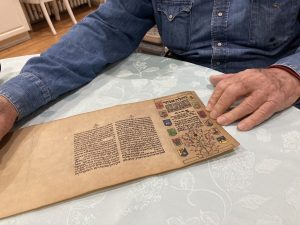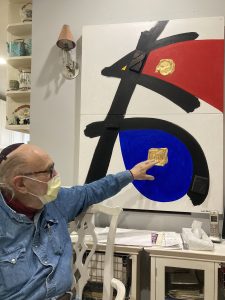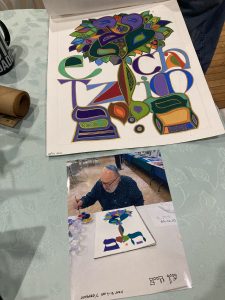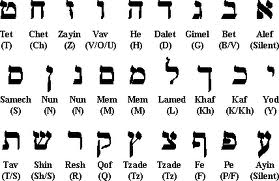
While studying at the Philadelphia Museum School of Art, Mordechai Rosenstein learned figure drawing and color theory, which he calls the “ABCs” of fine art, the fundamental skills needed to be an artist.
But Rosenstein had a fascination with his own ABCs, which served as his fundamentals before he even stepped into an art studio. For almost 80 years, Rosenstein has created calligraphy art, transforming the Hebrew alphabet, stretching characters and bending them into trees or musical notes and breathing new life and color into brachot.
In his 88 years, Rosenstein has created more than 700 pieces, and he has no plans of stopping soon. He most recently spent the weekend of Dec. 1-3 at Ohev Shalom of Bucks County, where he led community workshops and classes and created an art piece with the help of congregants and visitors.
“I sit there and people come and we let them fill in an area,” Rosenstein said. “They sign the list of artists, and then when a copy [of the painting] goes back to the synagogue to memorialize our visit, they also get a list of the artists.”
At a recent visit to Lombard, Illinois, Rosenstein created a calligraphy piece of Etz Chaim, the Tree of Life, with the Hebrew letters of “Etz Chaim” bending, twisting and elongating to form a tree’s trunk and branches. Community participants added additional designs, letters and leaves to the tree.

with one of his more recent
pieces, which contains recycled
carved blocks of Hebrew letters | Photo by Sasha Rogelberg
Though formally trained as an artist, Rosenstein’s manner of teaching his calligraphy is much more proletariat. He grabs a piece of printer paper and clicks a pen that was resting in his shirt pocket and starts drawing swoops of letters to create an uneven, curved rhombus. It’s a yud, he says, the foundational shape of all Hebrew letters.
He draws yuds of all shapes and sizes, which begin to interlock and form alephs and lameds. In the negative space within the letters, he draws symbols and shapes, transforming letters into musical notes on a staff and basketballs and soccer balls sitting above goals.
He cited the philosophy of abstract expressionist Franz Kline, also a professor at the Philadelphia Museum School of Art in the 1950s: “He said, ‘I don’t paint black on white; I paint black and white.’”
Rosenstein’s inspirations come from Jewish thinkers across millennia, beyond the mid-century artists of Philadelphia.
“In Kabbalah, they say that the space between letters are letters,” Rosenstein said, shading a shin with his pen. “This space, if you alter it, you affect the letters; you change them.”
Rosenstein’s art has always been woven into his Judaism. Attending Akiba Hebrew Academy — and graduating as part of the school’s first class in 1951 — Rosenstein fell in love with Hebrew letters but had an absence of materials from which to learn.
“As far as I knew, there was no scribe in Philadelphia, no sofer,” he said. “And there were no books from Israel showing all the typefaces.”
Rosenstein instead began to act as an amateur scribe, creating a Purim Megillah with intricate lettering and vibrant patches of color.
Born in 1934 in Strawberry Mansion, Rosenstein grew up with an American-born mother and Russian immigrant father, who would tell him stories of sipping tea from glasses — including empty yahrzeit candle holders — in his mother country.
Sticking to his immigrant sensibilities, Rosenstein’s father was skeptical of his son’s artistic passion.
“He felt that it would be really difficult and chancy to make a living,” Rosenstein said.
But Rosenstein’s mother supported him, buying him a big art set one year for Chanukah, containing crayons, clay and colored pencils, which Rosenstein fiddled with as a child. Rosenstein’s two uncles in the framing business helped guide the young artist, who decided to attend art school.
“I bought a pack of Camel cigarettes, a pair of what we call dungarees; I took off the kippah, and I went to the Philadelphia Museum School of Art,” Rosenstein said. “I wasn’t studying chumash anymore.”
In art school, Rosenstein was studying “to become the next Matisse,” doing figure drawings, paintings, weaving and silkscreen printing. But by the time he graduated, Rosenstein was a far cry from the famous French impressionist.
He instead joined the Army for two years, stationed in Columbia, South Carolina, drawing training aids for weapons and equipment. He then moved to New York City to get a job in the textile industry, working at 40th and Broadway as an assistant stylist, mostly doing administrative work and continuing his calligraphy art at home after hours.
It was there he met his wife and created the ketubah for their wedding. Rosenstein began to find his footing as an artist once more, creating ketubot for the several other Jewish couples getting married around the same time; he did the silver work for an exhibit for The Jewish Museum in Manhattan.
In 1967, Rosenstein got a letter from his uncle that his son died, so Rosenstein and his young family moved back to Philadelphia; Rosenstein became the foreman of his uncle’s factory until his uncle’s death about a decade later, at which point his cousin had sold the business. Rosenstein ran a frame shop in Northeast Philadelphia for a couple of years but found it difficult to make a living.
Around that time, Rita Poley, director and curator at the Temple Judea Museum at Reform Congregation Keneseth Israel, was the art education consultant for the Division of Community Services at Gratz College and was looking for Jewish artists to display their works. She stumbled across Rosenstein.
“I just took one look at his work, and I said, ‘I have to exhibit it,’” Poley said.
In 1979, Rosenstein was able to make his art his career and had one of his first art shows at La Salle College, now La Salle University, where he displayed only three pieces. He now displays about 40 pieces per show.
Since 2003, he’s worked with business partner Barry Magen, who was drawn to Rosenstein’s unique style.

“It has a modern way of looking at the Torah and a modern way of looking at the Hebrew alphabet because his pieces are not black and white people praying at the wall,” Magen said. “It’s very bright and creative, full of color and full of life, and, really, the big thing is that they’re happy.”
Though his subjects for more than 50 years, Hebrew calligraphy is still exciting to Rosenstein. His pieces vary in color and size and recently, he’s taken old wood blocks with Hebrew words carved into them, sent to him by a friend, to give his pieces a three-dimensional quality.
He was incredulous when asked if he ever got bored of creating the style of art.
“The letters? Are you kidding?!” he said. “They’re my companions.”





